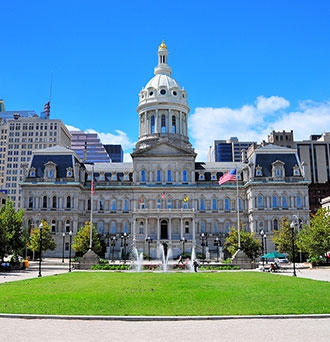
By Reid Capalino and Nathaniel Stinnett
Everybody knows that 2016 is a big election year. Over 120 million people will likely vote for our next President and Congress, and many will also be choosing new governors and state legislators.
But you probably don't know that tens of millions of Americans will also have the opportunity to vote for a new mayor in 2016.
And if you care about the environment, that's a big deal.
According to the U.S. Conference of Mayors, a total of 483 American cities will hold mayoral elections in 2016, including San Diego, Baltimore, Milwaukee, Sacramento, and Portland, OR. Eighty-seven of these cities have populations over 100,000, and most will choose their chief executives in relative silence, without any of the 24/7 media coverage that surrounds even the smallest Presidential caucus.
But here's the thing: mayors can save the planet, so if you care about the environment, you need to pay attention to these municipal elections...and you need to vote.
Over 71% of Americans live in cities of more than 50,000 people. We are an urban nation, and municipal governments have an enormous degree of control over energy use, air pollution, water pollution, and land conservation policies. With enlightened municipal leadership, our cities can lead the fight against climate change and create a cleaner, healthier, more sustainable country. To cite just a few examples:
Clean Heat Initiatives: In certain cities, the burning of No. 4 and No. 6 fuel oils to heat buildings is a major source of air pollution and associated health impacts. In 2011, New York City began its New York Retrofit Accelerator program, which combines new regulations, financial incentives, and some mandatory conversions to accelerate the shift to cleaner heating systems. As a result of this program - in just its first five years - citywide fine particulate matter levels have dropped 23% and sulfur-dioxide levels have dropped 69%. Over five years, this reduction in emissions has prevented an estimated 4,000 deaths and 10,000 hospital visits due to lung and cardiovascular disease.
Sustainable Municipal Buildings: Municipal governments are often the largest property owners in cities, providing major opportunities to improve the sustainability of our built environment. Many cities, including London, Paris, Seoul, Houston, and New York, have undertaken large retrofitting efforts. In particular, London has retrofit over 440 buildingsover the last 5 years, resulting in CO2 emissions reductions of 30,000 tons/year as well as energy cost savings between 25-35% for each retrofitted building.
Bus Rapid Transit: Bus Rapid Transit (BRT) is a relatively cheap, yet particularly effective, form of public transportation, largely operating in dedicated lanes where high capacity vehicles have right-of-way priority over other vehicles. BRT systems have been developed in many cities, including Bogota, Istanbul, Beijing, Jakarta, Helsinki, Barcelona, Montreal, Los Angeles, and New York. In 2000, Bogota created its TransMilenio BRT system, which is now the most-used BRT system in the world. While previously Bogota had 2,700 conventional buses to provide for 1.6 million daily riders, in 2013 Bogota used just 630 BRT buses to transport 1.9 daily riders. As a result of this BRT system, Bogota reduced emissions of CO2 by 1 million tons annually, sulfur dioxide by 43%, nitrogen oxides by 18%, and particulates by 12%.
Green Roofs: By requiring or incentivizing buildings to paint or plant on their roofs, cities can dramatically reduce both cooling energy costs and storm water runoff. Toronto, New York, Tokyo, London, and Melbourne already have eco-roof programs and - once implemented citywide - Toronto expects to save $42-$118 million on infrastructure savings, pollution reduction, and reduced erosion control needs. Additionally, Toronto projects $79 million in energy savings, as well as a reduction in the city's local ambient temperature by 0.5 to 2 degrees Celsius.
These policies are already having a huge impact on climate change and the environment, but here's the problem: cities aren't exactly lining up to enact measures like this. Why? Because most mayors - as politically progressive as they tend to be - are still politicians, and politicians tend to be much more responsive to the needs of people who vote than they are to the needs of people who don't vote.
Unfortunately, our research at the Environmental Voter Project reveals that most environmentalists never even think of voting in municipal elections. We see similar outcomes in demographic turnout studies showing that eligible voters over the age of 65 are 20 times more likely to vote in municipal elections than people between the ages of 18-34, which is a big problem for environmentalists because young people are significantly more likely to prioritize environmental issues than people over the age of 65.
We need to change this, and we need to start in 2016. Cities and towns should be easy pickings for the environmental movement - there's no congressional gridlock, no Koch brothers (at least not yet), and a largely non-partisan discussion of issues. Even a small increase in turnout among environmentalists could easily give mayors the nudge they need to lead on climate change and other environmental issues.
Voting in municipal elections is an easy way for environmentalists to start making a big difference. So let's make 2016 about voting in every election, and not just the Presidential election.
Reid Capalino is a Senior Energy Analyst with the Carbon Tracker Initiative and the Director of Energy & Resiliency at Capalino+Company. Reid also serves on the Board of Advisors of the Environmental Voter Project.
Nathaniel Stinnett is the Founder & CEO of the Environmental Voter Project.
